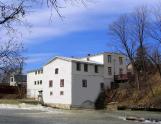17
The entire systemIn operation since 1762, the mill had to be modified several times in order to respond to the constant needs of production. All the modifications and additions made to it were part of the adaptation process and contributed to enhance its operation.
In comparison
Built in the middle of the 18th Century, the Légaré mill is difficult to compare to other mills from the same period, as they are very rare. Only three mills built around the middle of the 18th Century can be compared to the Saint-Eustache mill; they are the Gentilly mill, the Tonnancourt mill near Trois-Rivières and the Saint-Jean-Port-Joli mill. Built from rectangular rocks, the Michel mill at Gentilly also lost its bucket wheel in exchange for a turbine. However, this mill was not placed on as steep a slope as was the Légaré mill. Those four mills are similar in building techniques and machinery, but the Légaré mill is unique in the way it is integrated into the environment.
As for the mills built in the 19th Century, they are very different than our mill, with respect to the height of their structure, the higher number of openings and the generally gradual slope of their roofs. In summary, the Légaré mill illustrates well the first phase in the evolution of mills in Canada: a square brick building made with rectangular bricks, not very tall, with a few openings, the distribution of the work over two floors and the miller's lodgings integrated into the building. The modifications made during the 19th and 20th Centuries were only additions made to the existing structure.
22
Other designations and an evaluation of the communityOn November 4, 1976, under the name of the Légaré mill, the building and its site were classified as cultural possessions by the Government of Quebec; to which a protection area of 500 feet in circumference was added on September 6, 1977. In 2000, the mill was designated as a National Historic Site by the Federal Government.
The mill is the pride of the local and regional population, and more than 10,000 people visit it each year. Its doors are always open. (?On y entre comme dans un moulin, ? or ?You can come into this mill anytime,? is their slogan). Year-round, people can buy good wheat flour and buckwheat flour there. The mill also welcomes various cultural activities, and each September, it hosts the famous ?Festival de la galette et des saveurs du terroir? (Festival of buckwheat cakes and local dishes) which, in 2004, attracted more than 25,000 visitors over two days.







